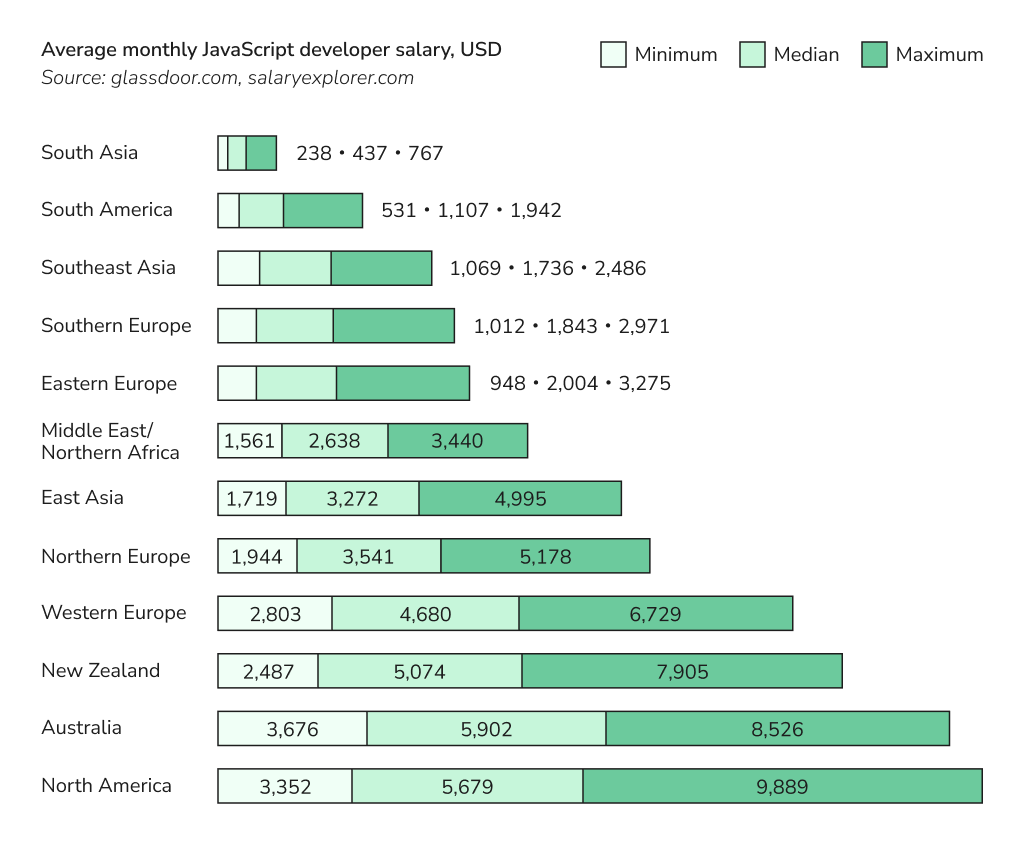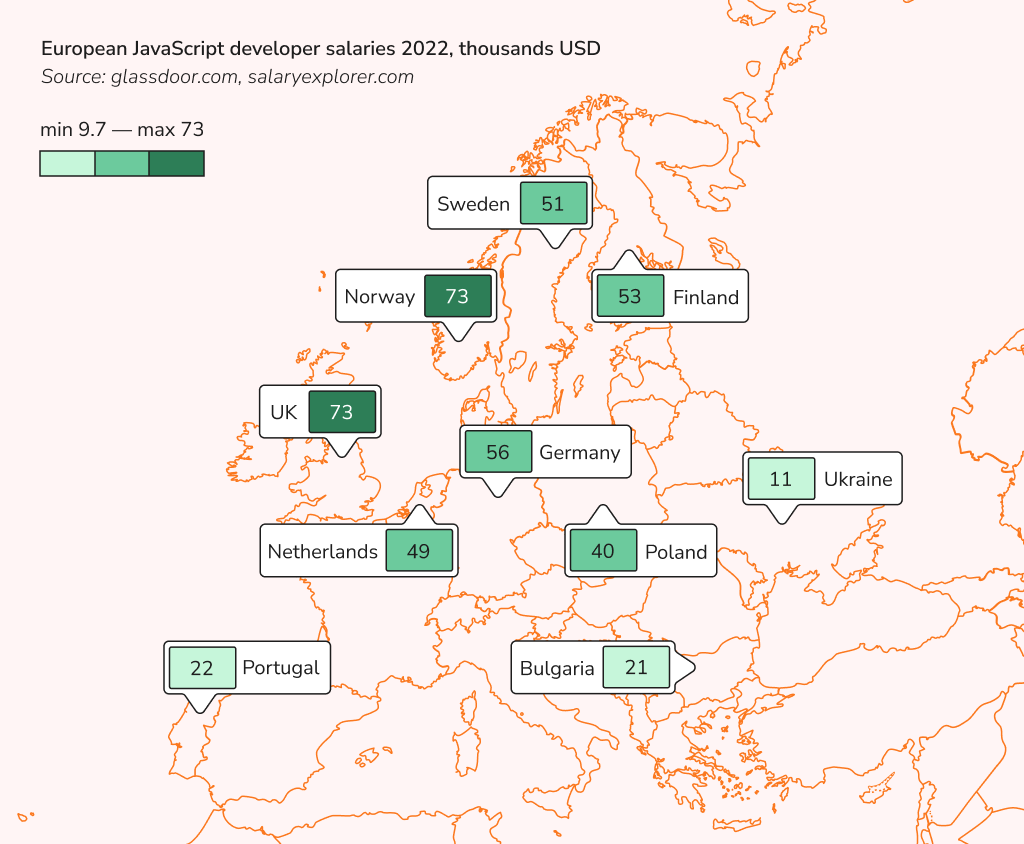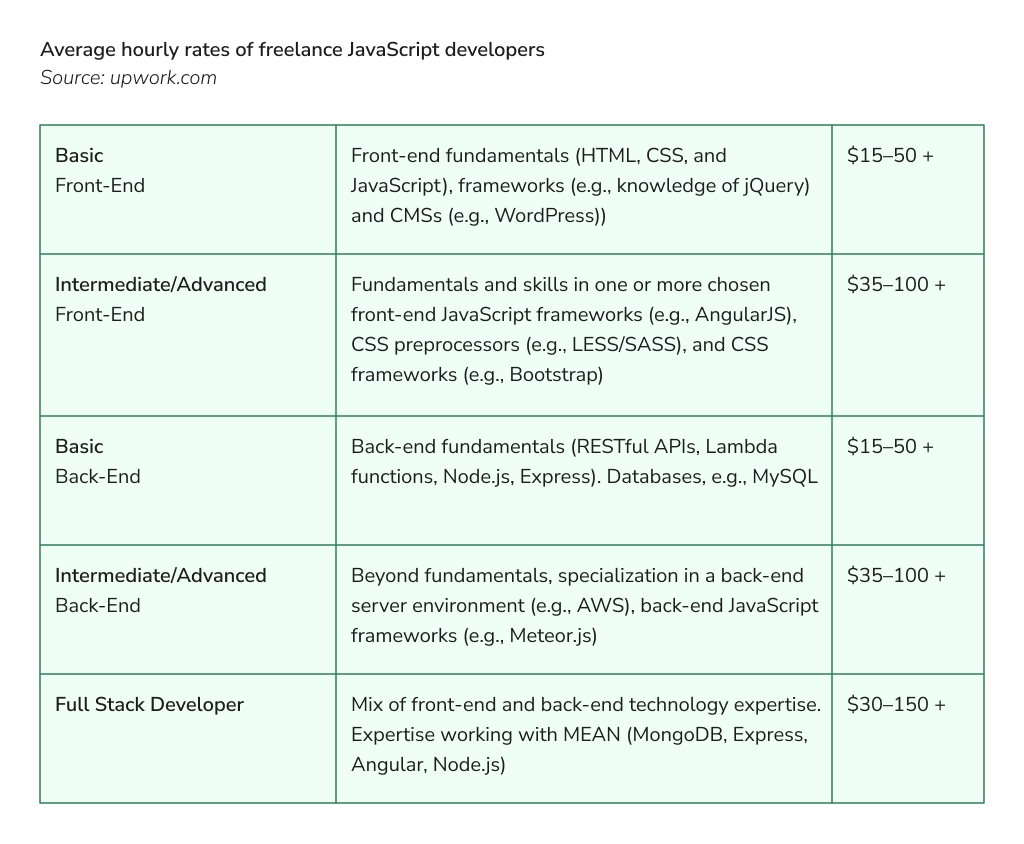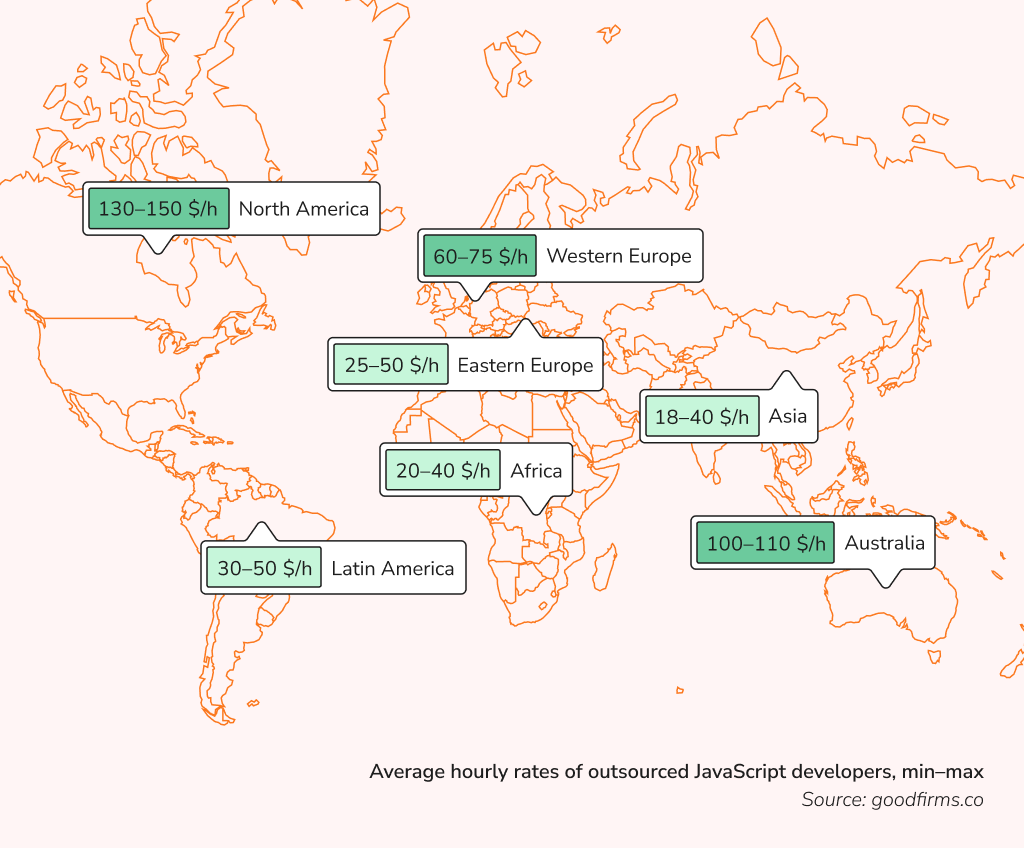
Finding the Best JavaScript Developer for Your Team: An Extensive Guide
Contents
Contents
Why JavaScript?
In 2007, Jeff Atwood (Stack Overflow’s co-founder) jokingly wrote that any application that could be written in JavaScript would eventually be written in JavaScript. And here we are fifteen years later, with JS still the most popular programming language among professional developers.
So whether you’re planning to build a single-page application, harness the power of the cloud, or create a simple website, JavaScript is fundamental for making the web dynamic and interactive.

Every product team needs a JavaScript developer
Including yours. Any web-based project cannot do without JavaScript programmers, but still, they are frequently underrated. Perhaps you have some devs in your team who are proficient in specific languages and frameworks — Python, Swift, PHP, Ruby, and know their job well. But here’s what you can accomplish with a JavaScript engineer on hand:
- Architect, design, and develop a web application to support internal and external stakeholders;
- Create end-to-end, industry-leading systems and solutions;
- Prototype new ideas, concepts, and designs without delay;
- Improve user interfaces, investigate and develop new web and mobile applications;
- Create engaging, easy-to-update dynamic content;
- Do all of the above using only one set of technologies.
What is the cost of hiring a full-time JavaScript developer?
Before setting a hiring budget, you need to consider a few things. First, in most cases, the compensation of JS engineers is relatively high, especially in the middle and senior segments. But it also largely depends on the region the developers originate from. And the reason is as evident as it seems: the cost of living varies from country to country, affecting the average income of every worker on the planet. So while qualified JavaScript developers are in high demand, their pay is also pre-determined by location.

Let’s see in numbers what JavaScript engineers make worldwide, according to the most recent pay statistics provided by Glassdoor and Salary Explorer.
North America
North American developer rates have traditionally been among the highest in the world. So if you have a limited project budget, you probably should not hunt for developers in this location. According to our estimation, the average yearly salary of a JS developer in the United States amounts to $98,500, followed by $73,300 in Canada and Mexico ($32,700).
The Middle East & Northern Africa (MENA)
Based on the available data, the weighted average annual salary of a JavaScript developer in the MENA region is about $32K. However, the rate distribution is unequal. For instance, the average pay of Israeli JS developers peaks at $106,200/year — even higher than in North America and Western Europe, and an average salary in the UAE ($58,900) is higher than in Germany ($55,570). At the same time, Egyptian JavaScript engineers would cost you less than $5K/year. Notably, due to the lack of skilled local talent, companies from the MENA region increasingly look for offshore developers to close the recruitment gap
South & Southeast Asia
South and Southeast Asia remain the most popular destinations to look for remote developers, as well as Eastern and Central Europe. Like in other IT domains, the most affordable JavaScript development rates are in Bangladesh, Sri Lanka (about $3K per year), and Pakistan ($5,200). India, Indonesia, and Nepal roughly fall into the salary range of $7-8K yearly, followed by Cambodia ($9,600). The highest regional JS developer rates are in Singapore ($54,400) and Malaysia ($23K).
East Asia
The region’s average annual JavaScript developer rate is roughly around $39K. In general, it is quite an expensive location to look for JS programmers — more costly than Eastern Europe and MENA. In China, the world’s largest labor market, an average yearly JavaScript dev’s salary is around $35K. Hong Kong ($53K/year) and Taiwan ($50K/year) offer the highest JS development rates in this area.
Australia & New Zealand
We singled out these two countries because of their geographical location (and because we love kangaroos and kiwis!), but they are relatively expensive for IT outstaffing. The average annual salary of JavaScript developers amounts to roughly $61K in New Zealand and $71K in Australia.

Western & Northern Europe
The rates of European developers tend to differ many times depending on the region. Generally, the rates are higher in the Nordic and Baltic countries and Western Europe. For example, JavaScript developers from Great Britain will be the most expensive ($73,200 per year), much the same as from Norway and Belgium ($73K and $63K, respectively). On the other hand, hiring developers in Lithuania ($12K) and Latvia ($23,600) appears to be quite advantageous on the cost side.
Eastern & Southern Europe
Eastern European countries are among the most attractive destinations for talent search regarding affordability and quality. On the regional scale, Albania and Moldova have the lowest rates (around $9,700 per year) — nearly one-tenth of the annual JS developers’ salary in the United States. Ukrainian JavaScript programmers are available at around $11,200/year. It is much less than the pay level in Hungary ($17,500), Romania ($20,200), Bulgaria ($20,500), Slovakia ($25,230), and Poland ($40K). You can check our recent guide on software development in Ukraine to learn more about the local IT market, especially if you consider cooperating with Ukrainian developers.

Types of JS developers to choose from
Because JavaScript is used on both the front- and back ends of websites, the challenge of selecting the right developers mainly depends on your current project’s status and team.
Front-end JavaScript developers
A front-end developer is “the one” to take care of your application’s client-side (UI). They are knowledgeable in user experience and design and convert mock-ups into functional interfaces. The most obvious choice will be the programmers familiar with React, Vue.js, and Angular. These are the market’s most actively used (and loved) frameworks suitable for smaller and wide-scale projects.
Back-end JavaScript developers
If you already have a front-end engineer(s) on your team, you need back-end developers to build and maintain the app’s server-side functionality that connects data with the front end. A hint on technology: 43% of JS programmers use Node.js for building enterprise apps, and 85% utilize it in web app development. So having a strong Node.js developer(s) would be a good investment when you need to create a scalable and reusable server side.
Full-stack JavaScript developers
Full-stack JavaScript developers can work on both the front and server sides and design your app’s user interface and inner mechanics. A full-stack team allows you to recruit developers with more experience in one area and less in another and get the job done with fewer people and lower overhead. They’re an excellent choice for more straightforward projects and applications with unbalanced complexity between the front-end and back-end.
Freelance JavaScript developers’ rates
As much as full-time salaries, the rates of JavaScript freelancers will vary depending on their location and the marketplace they use to seek jobs. Usually, those platforms add different premiums to the pricing, so it’s important to tell the reasonable rates. For example, Upwork, one of the biggest freelance marketplaces, allows you to hire JavaScript programmers who charge around $15-$35 per hour — the more experienced the freelancer, the higher the rate.
Beyond seniority, you also need to consider specific technical skills directly impacting your budget. We’ve broken down the pricing ranges of the typical JS developers available on Upwork and their responsibilities to shed some light on this matter.

At Beetroot, you can have the dependability of a remote team with the cost-effectiveness of freelance programmers. To understand more, visit our website, which includes a thorough overview of Beetroot’s dedicated team services.
What you need to know about freelancers
Let’s quickly recap some relevant advantages and disadvantages of working with freelance developers before you take a definitive position in this regard.
Pros
Cost. They are much less expensive than in-house or dedicated JavaScript developers.
Flexibility. Not bound by any bureaucracy, freelancers can be very flexible regarding deadlines and working hours.
Autonomy. When hiring individual freelancers, you have complete control over which freelancer is responsible for which aspects of the project, but you must source those skills separately.
Cons
Insufficient expertise. Finding developers with JS knowledge will be easy because it is so popular. However, they almost always frame themselves in a positive light but may indeed lack the knowledge needed in your project.
Reliability. You can’t hire just anyone who claims to be a JavaScript developer and risk your project by trusting them with sensitive data. Besides, it is not uncommon for freelancers to fail the deadlines or disappear without warning.
Code quality. You cannot check the code if you are not a qualified developer. So when working with freelance developers, they may underperform because they think you won’t tell the difference.
Dedicated JavaScript developers
Professional, dedicated JavaScript programmers know precisely what they’re doing and how to do it properly. These developers build clean code for performance and efficiency that is simple to understand, difficult to crack, and guarantees a higher return on investment.
Naturally, this quality comes with higher pricing. But it also covers administration, team support, and tailored recruitment. But if your goal is to complete a team with no hassle on your side, then partnering with a reliable vendor is right for you.
Based on the weighted data from GoodFirms, below, you can see the average rate distribution of the global companies that provide JavaScript developers.

What you need to know about outstaffing
We agree it’s tough to find the perfect balance between the cost-efficiency and quality of the work without risking any other aspects of the project. Working with dedicated developers has advantages and disadvantages as with any different model. Let’s talk about the positives first.
Pros
Proven expertise. Developers are hand-picked, together with you, in a custom hiring process. So you don’t have to worry that their portfolio is a scam.
High team engagement. The dedicated development team works only with you and is a part of your organization. As a result, there is a constant feedback loop between the teams.
Control and flexibility. You retain total control while taking advantage of the scalability and reduced administration.
Security. Dedicated developers work under regulations that restrict any exposure of sensitive data, ensuring that your project remains confidential.
Cons
Cost. The cost of hiring nearshore/offshore developers is significantly higher than that of freelance work because it includes several extra expenditures. Some of them might be redundant or unwanted in your case.
Communication. Sometimes, the development partners place an additional layer of managers between you and your JavaScript developers. One of the ways to minimize any potential miscommunication is to encourage honest and direct dialogue between the teams, as we do here at Beetroot.
So, make an informed choice after evaluating all the benefits and drawbacks you have learned and following your project needs. Let’s not be strangers — you can always reach out to us, and we will gladly assist you in finding the best solution.
Subscribe to blog updates
Get the best new articles in your inbox. Get the lastest content first.
Recent articles from our magazine
Contact Us
Find out how we can help extend your tech team for sustainable growth.






